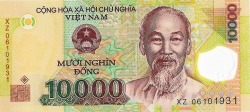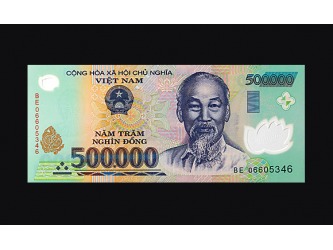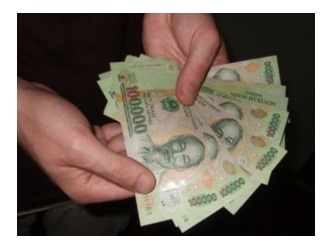CASH and CURRENCY
The Vietnamese currency is the dong. It's exchange value has been rapidly fluctuating in light of the current global financial crisis. It's value can be plus or minus as much as 5% within the same day of trading.
For example in 2008 through 2010, one Australian dollar has bought a fluctuating figure at the lowest of 10,400 dong and up to as high as 17,800 dong.
Vietnam is phasing out paper notes, and moving up by issuing polymer notes. I have posted some pictures on this page.
. A word of warning.... Be careful with the new 10,000 and 100,000 dong notes. The colours are very similar and often mistaken in poor light or those with a little colour blindness with grays and greens. You should be able to see the similarities with the 10,000 note at the top of this page and the 100,000 notes held in hand at the bottom of the page.
There also the blue 20,000 note, the pink 50,000 note and the larger 200,000 and 500,000 notes. Of the larger notes, you find street vendors will have difficulty in accepting a 100,000 note due to them having a lack of sufficient smaller notes to give change. So you can easily imagine the difficulty you will face with the two largest notes.
Throughout Vietnam, everybody accepts Vietnamese dong. Generally, only hotels and restaurants favouring foreign visitors advertise their prices in US dollars. Many street merchants punting to the foreigner ask for US dollars also.
Now there is a big tip here in saving you a fair bit of money. Those who ask for US dollars. I was looking at some leather goods from a street merchant. I asked the price, and the reply was $5 USD. I then asked, "How much in dong?" The answer was 50,000 dong. At that time, one US dollar was buying over 16,000 dong. This essentially meant that under the exchange rate, paying by USD would equate to over 80,000 dong.
If you need to exchange your foreign currency, virtually all hotels will accommodate you. But be wary of the exchange rates they offer you. They of course only offer currency exchange on the basis they can make a profit out of doing so, however, the exchange rate they offer could be substantially more in their favour then what is offered at banks. I asked at one hotel, and on each US dollar, they would give me 14,000 dong, while at that time, the bank up the street was offering over 15,000 dong in exchange. My advice - shop around.
CURRENCY CONVERTERS
http://wwp.greenwichmeantime.com/time-zone/asia/vietnam/currency.htm
http://coinmill.com/AUD_VND.html
COUNTERFEIT MONEY
In late 2008, it was featured on Vietnamese media about a sudden influx of counterfeit Vietnamese notes turning up across the country, but mainly in Hanoi. While Vietnam is now converting over to the polymer note, in the poverty and country areas, paper notes are still in abundance. The media reported it was mostly those people who were presenting counterfeit polymer notes to banks and city stores. It was suggested that the Vietnamese in the lower economy areas were receiving these notes, not able to quickly recognize they were fake, and as such, were passing them on. The pictures of the notes in the media were sufficient to show they were clearly poor fakes. Hence, anyone regularly handling them would spot the fake in a heart beat.
In 2007, an American fellow showed me two of the older style 10,000 dong notes he had received in change from a street merchant. When he retrieved them later from his breast pocket, he noticed they looked different to the norm. He showed them to me. While the paper was crisp and not wrinkled, the printed image presented as old and used. It was more than obvious they were computer scanned images printed on plain paper with a desk top printer, particularly since the serial number on both were identical.
.AUTOMATIC TELLER MACHINES - ATM's
In the major cities, you will have virtually no problem finding one. Interestingly enough, within 50 metres of the water puppet theatre entrance in Hanoi, would be at least a dozen of them. In the backpacker district of HCMC, there would be less than 50 metres between them. Meanwhile, at Sapa in the mountains of the north west, if there are more than three, it would surprise me. In the main street / tourist area there are two located about 200 metres apart. When I was there, one was off line and the other could not read my card. I needed to take a motor-bike taxi to another. All persons I spoke to told me it was about 3 kilometres away near the lake and all said there were just three machines in Sapa.
On two separate occasions in Vietnam, I encountered ATM machines that "swallowed" my card mid-transaction. There is a phone number on the machine to call for faults. So with a mobile phone in hand, you call and wait no more than 20 minutes for somebody to come along and retrieve it for you, but make sure you have your ID on you.
Be aware, all ATM's will charge an extra small fee for transactions against a foreign card.



